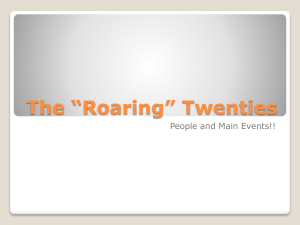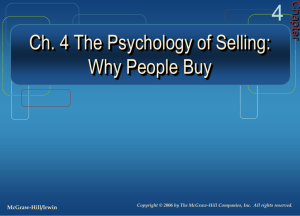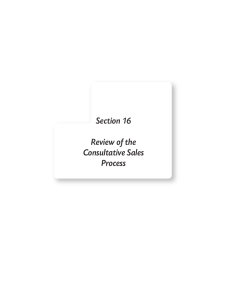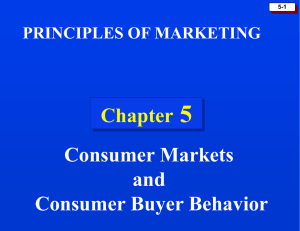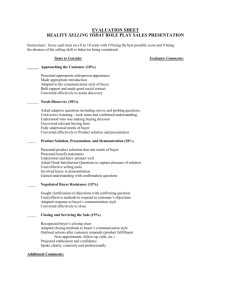File
advertisement
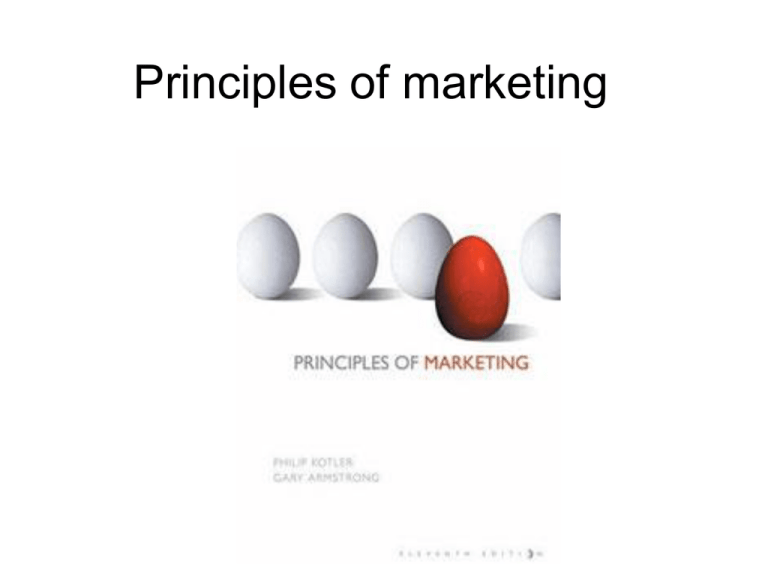
Principles of marketing Consumer Markets and Consumer Buyer Behavior Consumer Markets and Consumer Buyer Behavior • Consumer buyer behavior The buying behavior of final consumers – individuals and households that buy goods and services for personal consumption • Consumer Market All the individuals and households who buy or acquire goods and services for personal consumption Understanding the whys of buying behavior is very difficult. The mind is whirling , swirling, jumbled mass of neurons bouncing around….” The environment Marketing stimuli Other Product Economic Price Technological Place Social Promotion Cultural Buyer's black box Buyer's characteristics Buyer's decision process Buyer responses Buying attitudes and preferences Purchase behavior: what the buyer buys, when where and how much Brand company relationship behavior Characteristics Affecting Consumer Behavior Maslow’s Hierarchy of Needs Types of Buying Decision Behavior High Improvement Low involvement Significant differences Complex between brands buying behavior Varietyseeking buying behavior Few differences between brands Habitual buying behavior Dissonancereducing buying behavior High involvement but few perceived brand differences Cold feet is apprehension or doubt strong enough to prevent a planned course of action Consumer Markets and Consumer Buyer Behaviour Consumer Markets and Consumer Buyer Behavior Consumer Markets and Consumer Buyer Behaviour Need recognition Information search Cognitive dissonance Time of adoption of innovations Evaluation of alternatives Purchase decision Postpurchase behavior The Buyer Decision Process for New Products New product Adoption process Awareness Interest Evaluation Trial Adoption Time of adoption of innovations Influence of Product Characteristics on Rate of Adoption • Relative advantage • Compatibility • Complexity • Divisibility • Communicability Influence of Product Characteristics on Rate of Adoption Business Markets & Business Buyer Behavior Business Markets and Business Buyer Behavior • • • • • • Business buyer behavior The buying behavior of THE organization that buy goods and services for use in the production of other products and services or to resell or rent them to others at a profit Business markets operate “behind-the-scenes” to most consumers. Most of the things you buy involve many sets of business purchases before you ever see them Business buying process The decision process by which business buyers determine which products and services their organizations need to purchase, and then find, evaluate, and choose among alternative suppliers and brands Derived demand Business demand that ultimately comes from (derives from) the demand for consumer goods Supplier development Systematic development of networks of supplier-partners to ensure an appropriate & dependable supply of products & material for use in making products or reselling them to others Business Buyer Behavior • Business buying decisions can range from routine to incredibly complex, involving only a few or very many decision markers and buying influences Delivery terms & times Service terms Payment Cultural Source: Google search The nature and size of organizational markets Source: Google search Major Types of Buying Situations • • • • Straight re-buy Modified re-buy New task Systems selling (or solutions selling) Buying a packaged solution to a problem from a single seller, thus avoiding all the separate decisions involved in a complex buying situation Participation in the Business Buying Process • • • • • • Buying center Users Influencers Buyers Deciders Gatekeepers Major Influencers on Business Buyers Environmental Economic developments Supply conditions Technological change Political & regulatory developments Competitive developments Culture & customs Social Class Organizational Objectives Policies Procedures Organizational structure Interpersonal Authority Status Empathy Individual Age, income Education Job position, personality Risk attitudes Persuasiveness Systems The Business Buying process Problem recognition General need description Product specification supplier search Proposal solicitation Supplier selection Order-routine specification Performance review Buyer Purchase Process Source: Google search E-procurement • Purchasing through electronic connections between buyers and sellers – usually online Institutional & Government Markets • Institutional market Schools, hospitals, nursing homes, prisons, and other institutions that provide goods and services to people in their care • Government market Government units – federal, state, and local – that purchase or rent goods and services for carrying out the main functions of government Principles Of Marketing Building the right relationship with right customers - Quiz Butterflies: Good fit between company's Offering and customer's needs: high profit potential but short term customers True Friends: Good fit between company's Offerings and customer's Needs:Highest profit potential Strangers: Little fit between company's Offerings and customer's needs: lowest profit Potential Barnacles: Limited fit between company's offerings and customer's Needs: Low profit potential High profitability Potential profitability Low profitability Short term customers Long term customers Name: ______________ Projected Loyalty Principles of Marketing - Quiz • Dividing a market into distinct groups of buyer s who have different needs, characteristics, or behaviors, and who might require separate products or marketing programs. ________________ • A group of customers who respond in similar way to a given set of marketing effort ________________ • The process of evaluating each market segment’s attractiveness and selecting one or more segments to enter ________________ • Arranging for a product to occupy a clear, distinctive ,and desirable place relative to competing products in the mind of target customers. ________________ Positioning, Market Targeting, Market Segmentation, Market Segment. Thank You
